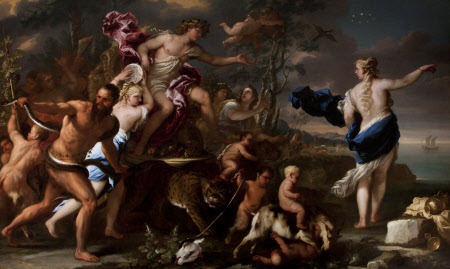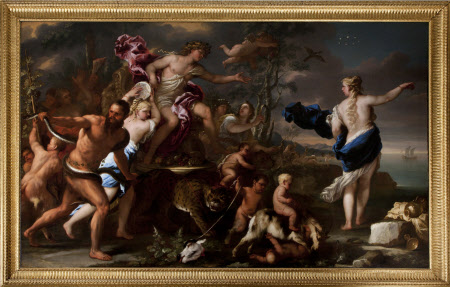The Triumph of Bacchus with Ariadne
Luca Giordano (Naples 1632 – Naples 1705)
Category
Art / Oil paintings
Date
circa 1682 (probably a Florentine picture)
Materials
Oil on canvas
Measurements
2426 x 4102 mm (95 ½ x 161 ½ in)
Place of origin
Florence
Order this imageCollection
Kedleston Hall, Derbyshire
NT 108848
Caption
The god of wine with his exotic and noisy retinue comes to the rescue of King Minos’s daughter who’s been churlishly abandoned by Theseus on the Greek island of Naxos. Despite her crucial role in helping the Athenian prince kill the minotaur in the labyrinth of her father’s palace at Knossos on Crete, his ship can be seen sailing away. The coronet of stars floating above Ariadne’s head refers to her constellation in the sky which was to be her wedding gift from Bacchus who has fallen in love with her at first sight.
Summary
Oil painting on canvas, The Triumph of Bacchus with Ariadne by Luca Giordano (Naples 1632 – Naples 1705). Bacchus seated left of centre in chariot drawn by cheetahs, left arm outstretched to Ariadne standing right. Ariadne full back, head turned left pointing out to sea with her right arm. To left of Bacchus is possibly a bearded Silenus with serpent. The chariot is surrounded by satyrs and maenads. Between Bacchus and Ariadne are three infant satyrs, one riding a goat, another pulling a dismembered animal head. Above Ariadne’s head is a ring of stars, to her right a seascape with a ship. Recently cleaned and restored.
Full description
Giordano started his painting career in Naples and subsequently moved to Rome, Florence and Venice where fresh influences moved him away from his earlier darker style. Titian (1487-1576) was one of the greatest Venetian painters and comparison between this Triumph and Titian’s Bacchus and Ariadne in the National Gallery, London, shows that Giordano must have been familiar with the Titian version of around 1520-3. The similarity in stature, physiognomy and snake symbolism of the large satyr (possibly Silenus through not representative of the usual form of a ‘gay, fat old drunkard’ ascribed to this usual member of Bacchus’s retinue) is strong, as is the swirl and movement in both depictions of Bacchus. The movement across the space and the positions of the principals also suggests that Giordano knowingly mirrored his version on that of Titian. Bacchus is the god of wine and usually wears a crown of vine leaves and grapes, often holds a Thyrsus, a wand tipped with a pine cone or entwined with ivy, and may be seen with a triumphal chariot drawn by tigers, leopards or goats, attended by satyrs and maenads, who usually empty wine pitchers in view, their contents having been consumed. Here Bacchus is beautiful and described by Milton as having: “clus’tring locks/ “With ivy berries wreath’d, and blithe in youth.” To the Renaissance humanists the passionate spirit of Bacchus (Dionysus) contrasted directly with the sober clarity of reason personified by Apollo. A satyr, a spirit of the woods, is usually depicted with hairy legs and hooves, and frequently wound ivy around the head or waist and entwined snakes (fertility symbols) around their bodies. They also played pipes. An infant satyr is depicted here dragging a goat’s decapitated head. Maenads or Bacchantes were female devotees of Bacchus dressed typically in swirling drapery, dancing and playing cymbals or tambourines with abandon. Nymphs dedicated to Bacchanalian rites were the natural targets of the lecherous satyrs. Triumphs music is represented in its percussive form; significantly perhaps, two kettle drums and a triangle are listed in the inventory and tambourines appear in Giordano’s Triumph of Bacchus with Ariadne and Rosselli’s The Israelites celebrating David’s triumph over Goliath. These pictures are also typical of Sir Nathaniel Curzon’s taste for seventeenth-century Italian artists admired by so many of his contemporaries on the Grand Tour. There is another painting by Giordano of similar subject matter - in reverse and more closely based on the famous work by Titian in the National Gallery, London - in the Herbert Art Gallery, Coventry. Giordano painted this one for the Rosso family in Florence. It covered an entire wall in their palace but was later sold and brought to England. Edward Ellice, MP for Coventry, gave the painting to Coventry in 1855. (Tania Adams)
Provenance
Probably acquired by William Kent (fl. 1742-1761) in Florence; William Kent’s sale, Langford’s, 14 February 1757 (118 gn); bought by Sir Nathaniel Curzon, 5th Bt (1726-1804; created 1st Lord Scarsdale in 1761); one of Curzon's first pictures bought for Kedleston Hall; recorded in the Drawing Room by Duchess of Northumberland, 1766; and thence by descent until bought with part of the contents of Kedleston with the aid of the National Heritage Memorial Fund in 1987 when the house and park were given to the National Trust by Francis Curzon, 3rd Viscount Scarsdale (1924-2000)
Credit line
Kedleston Hall, The Scarsdale Collection (acquired with the help of the National Heritage Memorial Fund and transferred to The National Trust in 1987)
Makers and roles
Luca Giordano (Naples 1632 – Naples 1705), publisher
References
Anon 1874 “The Private Collections of England. No.X – Kedleston Hall”, The Athenæum, 8 August 1874 Harris 1978 Leslie Harris, 'The Picture Collection at Kedleston Hall', The Connoisseur, July 1978, vol.198, no.79, pp. 208- 218 , vol.198, no.79, pp.208-18, pp. 208, 215, illus fig.B pp.212-213 Russell 1987 Francis Russell, “Securing the future: pictures at Kedleston Hall, Derbyshire.” Country Life, 23 July 1987, pp.96-99, fig. 7 on p.98 Ferrari and Scavazzi 1992 O. Ferrari & G. Scavazzi, Luca Giordano. L’opera completa, Naples, 1992, cat. A314,pp.60, 304


